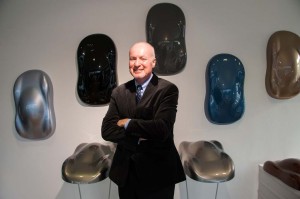
BASF color chief Paul Czornij with samples of paint colors likely to be popular over the next few years.
Henry Ford liked to tell his customers they could order a Model T in any color they wanted “as long as it’s black” – an option that certainly wouldn’t fly today.
Automakers today offer a wide ranging palette of colors, seemingly every shade between black and white, and the range of offerings continues to grow. BASF, one of the industry’s largest paint suppliers, is showing off 65 new hues to automotive designers as part of its annual color trend show.
While a handful of shades continue to dominate — black, white, silver and gray – other popular shades are strongly influenced by factors ranging from current events to consumer electronics, as well as increasing concerns about the environment, explains Paul Czornij, the technical manager of BASF’s Color Excellence Group.
Greens are becoming increasingly popular, as are blues, he notes, reflecting environmental concerns that have increased demand for all sorts of earth tone shades. Meanwhile, white is taking over from the long-popular silver shades, says Czornij, which appears to be linked to growing concerns “on both sides of the political spectrum…that things are not working right.”
White has also been buoyed by trends in consumer electronics, the BASF color specialist notes. The trendsetting Apple iPhone made white a symbol of high technology, something long associated with silver – a color that has been losing momentum over the last several years, according to industry sales data.
Today’s high-tech paints, meanwhile, allow designers to specify a wide range of shades, rather than simple primary colors, explains Czornij. When it comes to green, for example, “The nice things is that you can create a lot of different offerings,” from light to dark shades, “and you can even make very greenish blues or greenish yellows.”
The general trend for the 2014 model-year, Czornij anticipates, will be “more and more rich, saturated colors.” But even for white you’ll see more subtle variations in tone and gloss. In fact, one of the potentially biggest trends over the next few years is the move to lower gloss paints, whether they’re a satiny or even a matte finish.
Matte is, in fact, a favorite for automotive designers. The problem is that this ultra-low gloss finish can be extremely difficult to maintain – and equally costly to repair. That has the chemists behind the paint industry scrambling to come up with ways to make matte finishes easier to work and live with.
Researchers are not only exploring new colors and finishes but also trying to respond to consumer demands for more environmentally friendly paints. Over the last decade, the industry has moved almost entirely to waterborne compounds that sharply reduce the chemical emissions of old, petroleum-based solvents.
The next step BASF is studying would actually use “repurposed” compounds in the paint formula. At the annual trend show the company is showing off a new formula that uses ultra-fine rubber from recycled tires. The concept is still “very experimental,” Czornij cautions, and it’s too early to say if and when it would go into production.
BASF is also showing off experimental paint compounds that could be used to reduce solar load, the amount of energy soaked up by a car parked in a lot on a hot day in Phoenix, for example.
Because of the long lead times required in the auto industry – such as the need to test the durability of new paints – this year’s trend show focuses on paints and colors targeted at the 2017 model-year.
Along with greens and blues, American car buyers are expected to have a growing interest in browns over the next several years.
But color choices are typically quite different in other parts of the world. BASF forecasts “sophisticated intermediate colors, such as olive-greens and bluish grays” will become increasingly popular in the Asia-Pacific region. In recession-ravaged Europe, “there is a tendency to move forward rationally and calmly,” the paint supplier suggests, anticipating neutral black and gray will be particularly popular — while also predicting that “creative, courageous colors,” such as red and green will gain momentum over the next several years.

The paint manufacturers are to be applauded for attempting to bring different and unusual colors to the OEMs. Getting the buying public to accept and actually purchase vehicles in the unusual colors is a different matter. People are afraid to stand out or go out on a limb. Every other car on the road is either black, white, silver, or gray (dark silver) – boring.
IME automobile colors are influenced more by what the paint companies offer and what some focus group at the car maker think is hip this week…
Today’s parking lots look like an old B&W photo with their endless rows of black, white, silver and gray vehicles. Where’s the color? Look at any Sixties or Seventies car brochure. Every hue you could think of and then some was available back then, even on family sedans. GM’s legendary styling VP Harley Earl spent 40 years making cars colorful; he’d paint the air blue (pun intended) if he saw today’s “any color you want as long as it’s a shade of gray” automobiles.
My iPhone? Probably not. No wonder we get what (?) BASF gives us. Sure, make it pretty, but not too smart, and give them a new one every year but not all those really cool tech features the android/windows guys and gals can offer.
BTW..if you have to write an article about the topic why not include the 70%?